Art by Drew Struzan.
One of my current commissions is a piece of art for a book based on John Carpenter’s The Thing, due to be published next year. This was a request I agreed to immediately, having been astonished by the film when it appeared in 1982 (I saw it three times), and having rated it ever since as Carpenter’s best and also one of my all-time favourite horror films. I haven’t started on the planned piece just yet but the commission encouraged me to upgrade my DVD copy of the film to the Blu-ray version, and to also read for the first time John W. Campbell’s Who Goes There? (1938), the short story that was the origin of Carpenter’s film and also the 1951 adaptation directed by Christian Nyby. Reading the story set me hunting around for other interpretations of Campbell’s alien.
UK poster. Art by Les Edwards.
The story was instructive in several ways, the first being how closely Bill Lancaster’s script for the Carpenter film follows the story’s outline. The paperback collection I was reading has an introduction by James Blish which complains about the Howard Hawks/Christian Nyby production turning the polymorphous alien into another clone of Frankenstein’s monster. That’s true but the Nyby film still scared me to death when I first saw it aged 11 or so, and it has its merits. Lancaster not only stayed closer to the original shape-shifting premise but also kept many of the character names, plus details such as the blood test and the Thing’s attempt at the end to build a machine to escape from the encampment. The unforgettable opening, however, with the lone helicopter pursuing the dog, is all Lancaster’s.
Astounding Science-Fiction, August 1938; artist unknown. “Don A. Stuart” was a pseudonym for John W. Campbell, at that time the newly appointed editor of Astounding. Campbell’s editorship changed the name of the magazine from Astounding Stories to Astounding Science-Fiction.
It was face up there on the plain, greasy planks of the table. The broken haft of the bronze ice-axe was still buried in the queer skull. Three mad, hate-filled eyes blazed up with a living fire, bright as fresh-spilled blood, from a face ringed with a writhing, loathsome nest of worms, blue, mobile worms that crawled where hair should grow—
Campbell’s description of the ice-bound alien is better than some of his writing elsewhere. I’m used to tempering my judgement when visiting stories written for the pulps but Campbell’s writing is really awful, and a reminder of why I never got very far with the early SF writers. Weird Tales magazine had its share of ham-fisted journeymen (and women) but Campbell’s contemporaries such as Clark Ashton Smith and HP Lovecraft read like the most finessed and mandarin prose stylists in comparison. But The Thing isn’t the first great film to be based on a poor-quality story so we can at least thank Campbell for his scenario, although how much of it was his own has never been clear. The idea of ancient aliens in Antarctica (some of which are amorphous shape-shifters) had already been explored by HP Lovecraft in At the Mountains of Madness; Lovecraft’s story was published in 1936 by Astounding Stories, the same magazine that published Who Goes There? two years later. This lineage, and the possible influence, makes The Thing one of the foremost Lovecraftian films even without all of its tentacled abominations.
Art by Hannes Bok.
The story provided the title of Campbell’s debut collection of short fiction in 1948. I’ve known the Hannes Bok cover art for many years but hadn’t realised until recently that the three-eyed monster on the front was a Bokian rendering of Campbell’s alien. The figure on the back is presumably a human/husky hybrid, while I’d guess the robot relates to one of the author’s other stories.
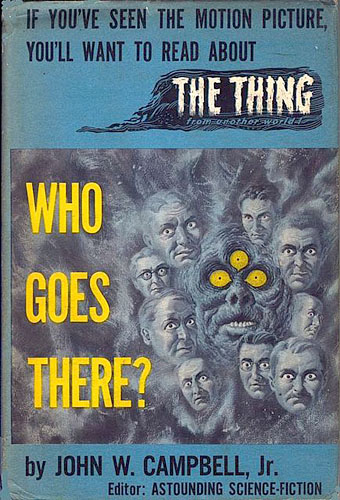
Art by Malcolm Smith.
After a good start, things (so to speak) begin to go awry. The story collection was reprinted in 1952 to capitalise on the release of the Hawks/Nyby film, and while the ape-faced alien may have the requisite three eyes, the two-eyed vegetable creature in the film is a much more horrifying presence.
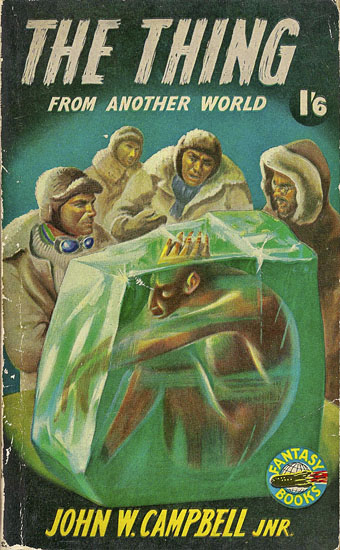
Art by Terry Maloney.
A UK paperback of the same collection from the same year but with Campbell’s title replaced by that of the film. Another ape-like alien that bears little resemblance to Campbell’s description.
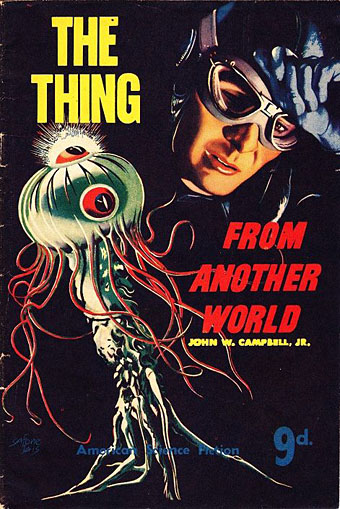
Artist unknown.
A 1952 Australian reprint of the same collection, and a cover that could easily be used on many other books.
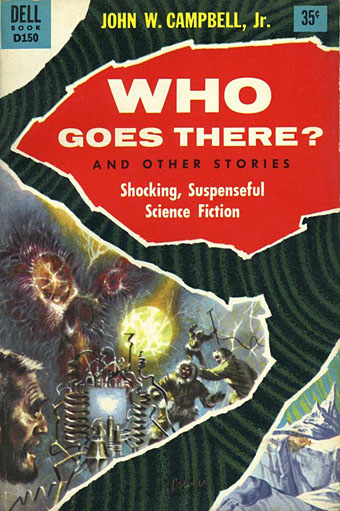
Art by Richard Powers.
A collection from 1955 with a different selection of stories. Not the best work from the great Richard Powers but he does a better job of communicating the threat and mayhem in the story.
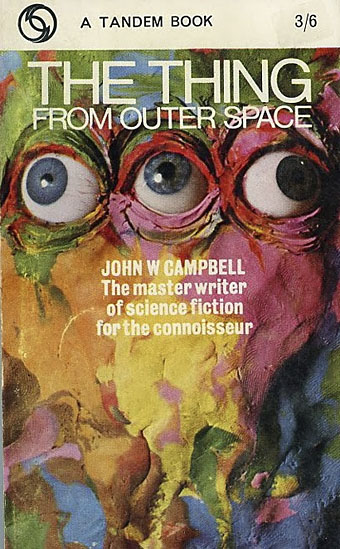
Glass eyes and a packet of plasticine, or abject laziness from Tandem. Among the other books published by this UK imprint in 1966 was Dead Fingers Talk by William Burroughs. The cover for that one was more typical pulp fare.
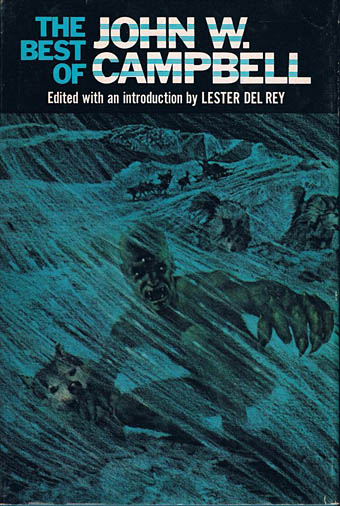
Art by Chet Jezierski.
A memorial collection from 1976 (Campbell had died five years earlier) with artwork that unusually combines the thorn-fingered humanoid from the Hawks/Nyby film with Campbell’s three-eyed alien. This is the first cover that makes Who Goes There? seem like a work of horror rather than regular science fiction.
Not a book cover but the opening of a 17-page comic-strip adaptation by Arnold Drake and Jack Abel. The strip is primitive but it follows Campbell’s story very closely. The comic appeared in 1976, and may not have been reprinted since. Read it here.
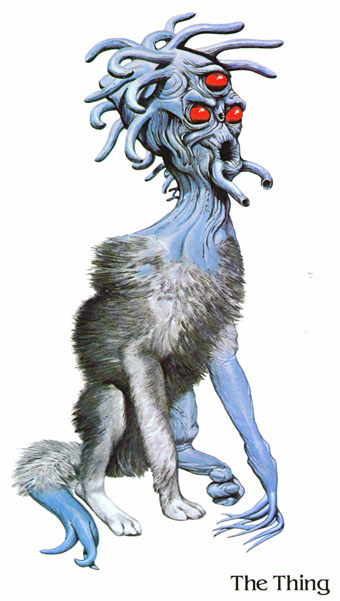
Artist Wayne Barlowe’s first book was a collection of alien portraits, Barlowe’s Guide to Extraterrestrials, published in 1979. Barlowe includes two renderings of Campbell’s Thing, the second of which is this dog hybrid. Not as overtly horrifying as some of his later art but then he was illustrating a book for general SF readers.
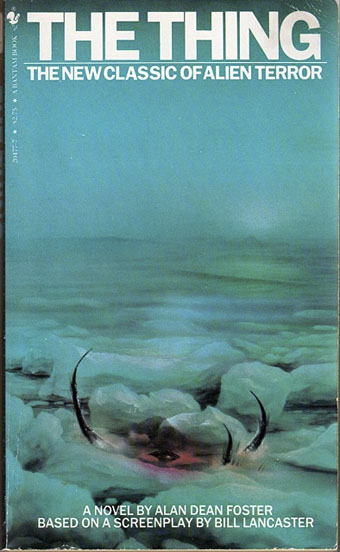
Artist unknown.
And so to Carpenter’s film, and the inevitable novelisation from one of the leading exponents of the form, Alan Dean Foster. This is a much better cover than the one for the UK edition which was a poor imitation of the US poster.
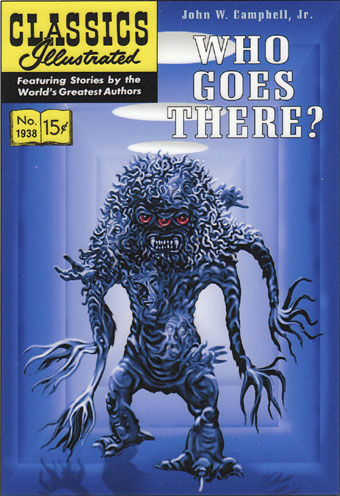
Art by Pete Von Sholly.
A slight cheat since this is one of a series of imaginary covers for Classics Illustrated. Genuine or not, Pete Von Sholly’s monster is very much the way Campbell describes it.
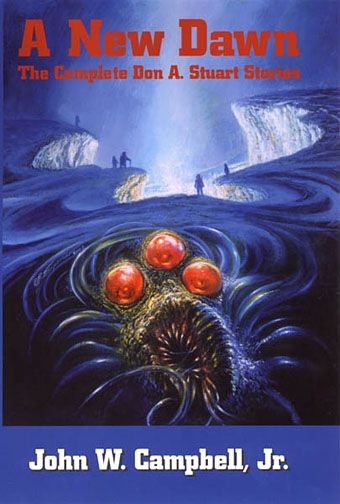
Art by Bob Eggleton.
One of the most recent renderings, and one of the best, for a 2003 collection of Campbell’s pseudonymous fiction of the 1930s. Bob Eggleton is an excellent artist with a fine line in Lovecraftian paintings (we were both represented in the Ars Necronomica art show in Providence last year) so he’s a good choice for this.
As for my Thing, I have an elaborate piece in mind so I’ve been doing more sketching than usual. Once the workload has calmed down I’ll be making a start, and I’ll also post any further news about The Thing: Artbook. Douglas Spencer’s closing words in The Thing from Another World are especially apt this time round: “Watch the skies!”
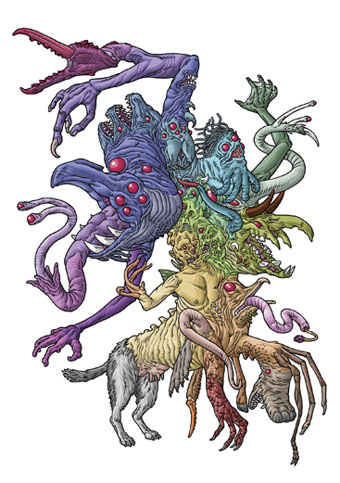
Art by Michael Bukowski.
Update: I knew I’d forgotten something… Michael Bukowski, another of the Ars Necronomica artists, drew this mutant form earlier this year. Thanks to The joey Zone for the reminder.
Elsewhere on { feuilleton }
• The book covers archive
Previously on { feuilleton }
• Snowbound cinema
• At the Mountains of Madness

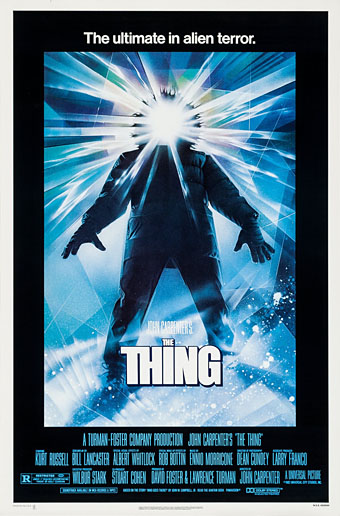
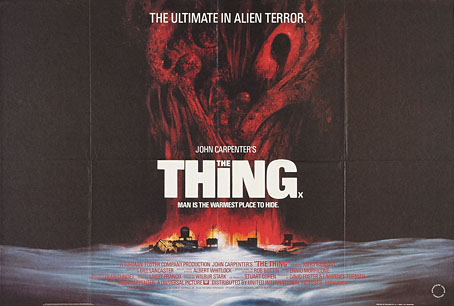
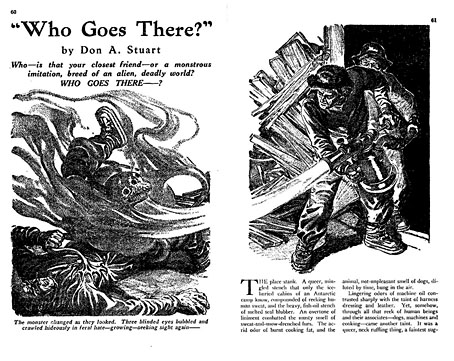
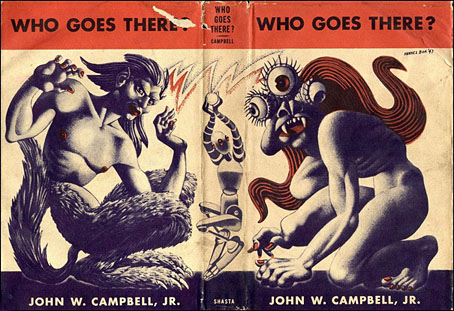
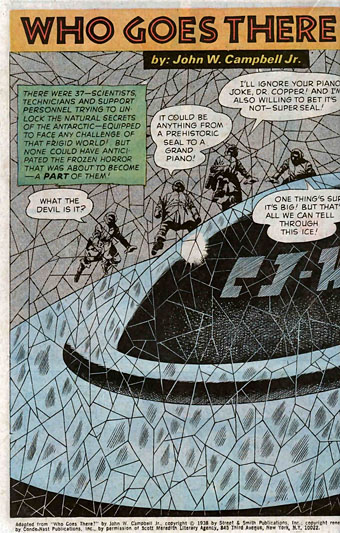
While you’re exploring versions, are you aware of this short story (The Things) giving the alien’s point of view?
http://clarkesworldmagazine.com/watts_01_10/
Hi Laurel. Yes, thanks, I’ve known about that since it first appeared but I was concerned here with tracing the visual history. Even that had to be limited otherwise you start wandering into other areas. So no mention of Horror Express, another film based on Campbell’s story, and aside from Pete Von Sholly’s piece there’s also no fan art. Carpenter’s film has inspired a lot of the latter, some of which may well be in the forthcoming art book.
There’s a nerdier take in the recent The Thing Itself by Adam Roberts.
Not a book cover but perhaps a tie-in to the plasticine cover image you included above: https://youtu.be/QAoONl2P8fw
I agree Carpenter’s THE THING is an astonishing film. My favourite Thing-form, I think, is the Palmer-Thing; the way it begins to hideously metamorphose probably disturbed me even more than the other abominations. I don’t suppose you have a favourite form?
I was in the middle of watching the original 1951 film years ago, but I never got around to finishing it. I suppose the Frankenstein’s Monster clone simply pales in comparison to the amorphous abomination(s) of the original story and remake. And I have yet to get round to reading Campbell’s story, which I have been putting off for a year.
By the way, have you seen MONSTERS FROM THE ID? It’s a stop-motion animation using Lego on YouTube that I have enjoyed since 2007. It uses dialogue and music from both THE THING films, as well as other science fiction horror films, and is worth watching.
Johann: Thanks, I didn’t know that although I did wonder given that the title has several applications.
Adam: Lee Hardcastle’s Thingu is a masterpiece which has been linked here in the past.
Liam: It was always the dog that impressed me the most.
The 1951 film is spoiled by the endless wisecracking and the ridiculous behaviour of the chief scientist. But I still think it’s an effective drama. One detail I noticed when I watched it again recently is that it’s the first of all the films containing a bleeping box warning of the approach of the monster. In that respect it also leads to Alien and its sequels.
I’ve not seen the Lego animation. The proliferation of Lego animations overwhelmed my patience some time ago with the result that I’ve been ignoring all mention of them for years.
I saw the original THE THING FROM ANOTHER WORLD, in glorious black and white, when I was ten. It scared the crap out of me to the point that I literally would “Watch the skies>’ Then came Carpenter’s THE THING, and it is my favorite movie period. I even follow a personal ritual of watching it for Halloween with a bottle of scotch next to me.
I also own proudly a “Norris Creature and Spider” and a “Blair Monster” from McFarlane Toys.Both are accurate models of the movie’s monsters or avatars of the original alien. Great post!
A SFX nerd writes: The original film features the first ”full body burn’ ever seen in films in the scene where the creature is doused in petrol and set on fire.
https://www.youtube.com/watch?v=kl-Y8ZkUenk
That’s easily the best scene in the film. Still thrilling and looks dangerous too, as it no doubt was at the time.
On a related note, Jack Finney’s ‘Invasion of the Body Snatchers’ which also spawned a very good ’50s film and superior remake [1978] (we’ll skip over most of Abel Ferrara’s ‘Bodysnatchers [1993]’ and all of ‘The Invasion’ [2007]), is similarly appallingly written.
Kaufman’s Body Snatchers is another favourite of mine. An underrated director.